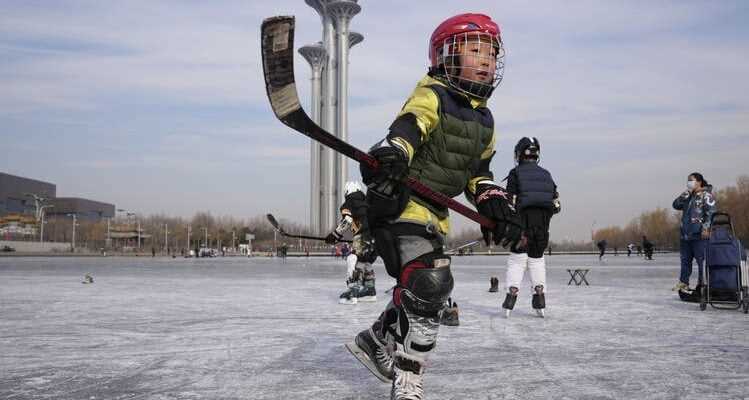Even if the country has no tradition of winter sports, among the better-off Chinese, enthusiasm for ice hockey, alpine skiing and figure skating is growing.
There is still space on the ice rinks – compared to 2015, the ice rinks have increased by 317 percent.
Why 300 million? 300 million Chinese should be involved in some form of winter sports by the start of the Winter Olympics. This is what Beijing’s planners decided in the “Winter Sports Development Plan 2016-2025” after China was awarded the 2015 Olympic Games 2022 contract. Experts puzzled. 300 million, roughly the population of northern China, joked one of them.
These games will now open in Beijing on Friday. And as is so often the case when China’s government makes a plan, it ends up announcing, in the best socialist manner, that it has overachieved. Around 346 million people have been introduced to winter sports in recent years China’s statisticians known in January. Thomas Bach, President of the International Olympic Committee, congratulated shortly afterwards at his meeting with China’s head of state and party leader Xi Jinping and praised: “In China, a new era for global winter sports begins with the games.” Can’t get any bigger.
Target with a symbolic character
Even if the ambitious target is probably more of a symbolic nature and the truthfulness of its achievement can hardly be verified: In China, a country without any tradition of winter sports, with minimal precipitation in the cold regions in the north and a subtropical climate in the south, winter sports are taking place – from a coming from a low level – gradually increasing. According to the state China Daily newspaper the number of ski tourists increased by 67 percent between 2015 and 2019. The winter sports sector is said to have generated sales of 94 billion dollars in 2020.
Most of the skiers who hit the slopes around Beijing on the weekends got in touch with the sport during stays abroad in Europe or the USA. But recently, more and more newcomers have dared to try the sport. On the slopes, this is often recognizable by the rather daring driving manoeuvres. Many Chinese want to save themselves the time and money involved in ski courses lasting several days.
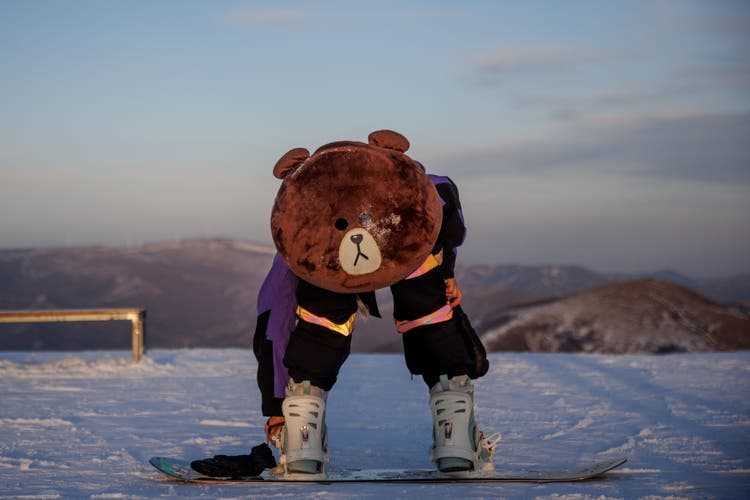
To make it easier – a snowboarder is on the move with a pillow in the Thaiwoo Ski Resort.
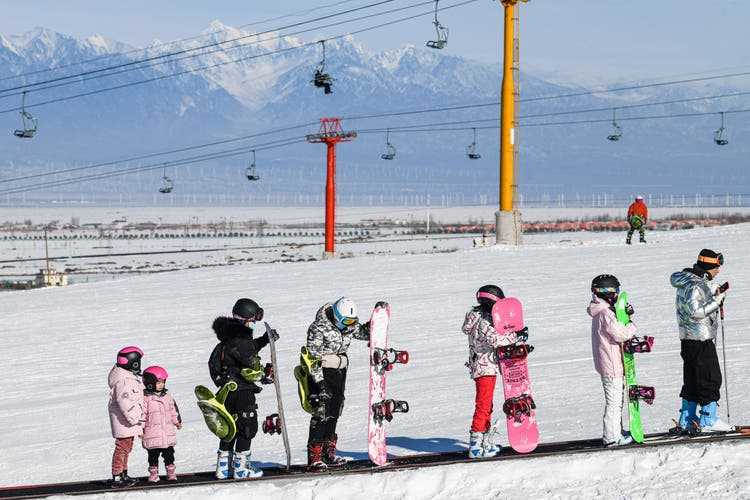
Children, fully equipped, on the magic carpet at the Baiyun Ski Resort.
Other winter sports are also attracting more and more attention. For example, the ice rinks in the Beijing shopping centers China World and Solana are regularly overcrowded at weekends. There are no official figures. But parents with high incomes are increasingly registering their daughters for figure skating and their sons for ice hockey. “More and more Chinese can afford such sports,” says Mark Dreyer, British expert on the Chinese sports industry. In addition to academic training, members of the middle class now attach great importance to the physical fitness of their offspring.
Authorities create the necessary infrastructure
As in other industries, China’s planning authorities are investing huge sums in winter sports and tax breaks for providing the necessary infrastructure so that the plan goals can be achieved. Should be between 2018 and 2020 $140 billion have been invested. In recent years, ice rinks, ski resorts and indoor slopes have sprung up all over the country. China now has a total of 803 ski resorts and 654 standard ice rinks, the country’s statisticians proudly announced in January. The latter recorded an increase of 317 percent compared to 2015.
In total there are 803 ski resorts in China.
The activities are supported by the country’s economic planning authorities. The government is trying to persuade companies to invest in the production of winter sports articles with tax concessions and the lease of industrial land. In Zhangjiakou near Chongli, where a large part of the competitions take place at the Winter Games, the authorities want a business park for the winter sports industry to be created.
So far, however, the ambitious project has been more like a delicate little plant that still needs a lot of water. 48 companies signed up, there was room for 100, 12 actually came, including some manufacturers from Taiwan, France and Italy. Covid-19 has also slowed down the plans. According to a spokesman for the industrial park, three more settlements are expected in the current year.
No chances of getting a medal
Despite all these efforts, a flood of medals from China is not imminent. Experts assume that the country can count on six gold medals at best. That would be five more than at the games in South Korea four years ago. Dreyer, the expert on the Chinese sports industry, has lived in China for 14 years and knows the sports sector well. He sees medal opportunities in speed skating, freestyle skiing, snowboarding and figure skating.
In recent years, China has gone to great lengths to nominate as large a team as possible for the Winter Games; local athletes will be at the start in almost all disciplines. The team that will arrive at the Beijing Olympic Stadium on Friday includes around 170 athletes. That is twice as many as in 2018 in South Korea.
This also required tricks. The state associations have retrained a number of athletes from track and field to become winter sports enthusiasts. In this way, long-distance runners became biathletes and cross-country skiers. Chen Degen from the tropical province of Yunnan, for example, was sent to Norway for biathlon training in 2019 by the authorities. The 20-year-old has no chance of winning a medal, but according to observers his progress in just three years is impressive. “The authorities hope that China will be a real winter sports nation in four, eight or twelve years,” writes Dreyer in an essay for the “Supchina” portal.
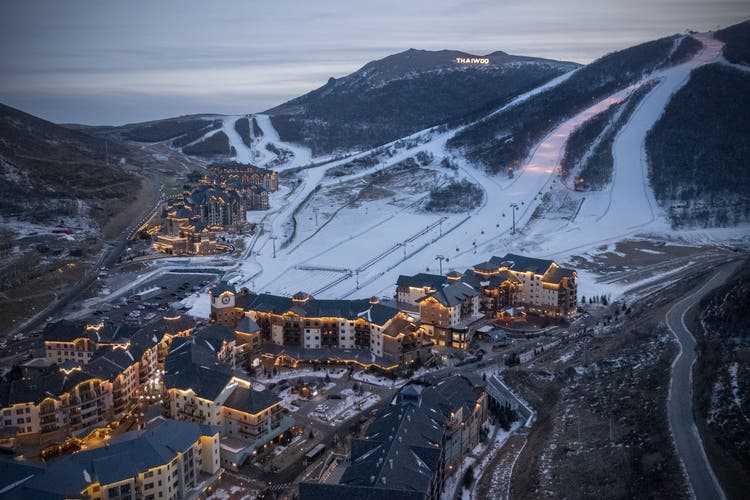
Thaiwoo is one of 803 ski resorts in China.
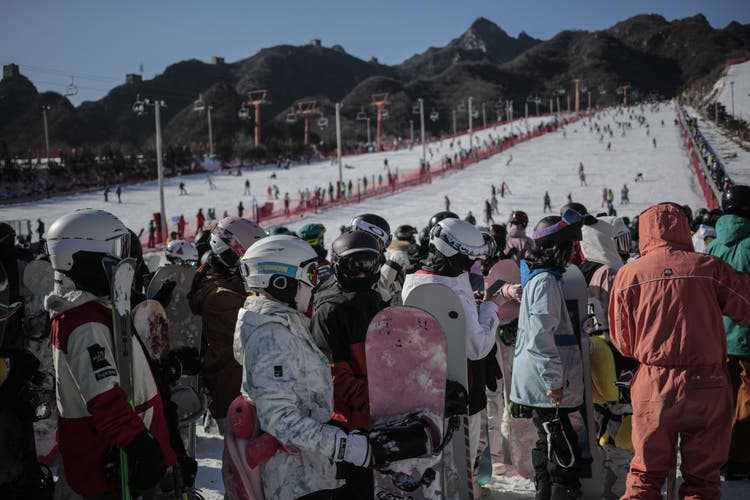
According to official figures, around 346 million people in China have been introduced to winter sports in recent years.
Ice hockey players from USA and Canada
As in the preparations for the 2008 Beijing Summer Games, China has hired several dozen foreign coaches for the 2022 Winter Games. And in order not to be completely lost in hockey, 15 players were recruited and naturalized for the men’s team in the USA and Canada, although it is unclear which of them surrendered their original passport. As is so often the case in China, money is not an issue: China has built a wind tunnel for its ski jumpers, the likes of which are few in the world.
Despite the effort and ingenuity, the Chinese national anthem is unlikely to be heard much in the next two weeks or so. But with the foundations that China has now laid, it can be considered certain that the country will do significantly better at the Winter Games in Italy four years from now.
